Moderator: Redaktörer
Morello skrev:Jag klankar inte ned på någon teknik; jag försökte bara förklara varför mätningarna i tråden inte är jämförbara. Man kan frestas att tro att klass D-steget presterar i paritet med NAD-steget, men förstår man den mättekniska skillnaden inses lätt att så ingalunda är fallet.
Morello skrev:Ja, precis, tekniken är inte riktigt mogen ännu. Switchfrekvensen (vad heter det på svenska?) behöver ökas avsevärt, men det mäktar inte dagens MOSFET-trissor med. Som Ingvar Öhman påpekat många gånger, fungerar dock dagens och gårdagens klass D-stärkare utmärkt till bashögtalarbruk.
Morello skrev:Jag klankar inte ned på någon teknik; jag försökte bara förklara varför mätningarna i tråden inte är jämförbara. Man kan frestas att tro att klass D-steget presterar i paritet med NAD-steget, men förstår man den mättekniska skillnaden inses lätt att så ingalunda är fallet.
Morello skrev:Ha i åminnelse att klass-D-apparater ofta mäts med lågpassfilter mellan testobjekt och analysator:
"The C 298 has an output stage operating in class-D, so I inserted an Audio Precision auxiliary AUX-0025 passive low-pass filter between the test load and my Audio Precision SYS2722 system (see the January 2008 "As We See It"). This filter eliminates RF noise that could drive the SYS2722's input circuitry into slew-rate limiting, and I used it for all the tests other than frequency response."
AUX 0025 har en öfvre gränsfrekvens om 25 kHz, vilket medför att THD-mätningar över cirka 7 kHz ger nonsensdata.
genstruktur skrev:Kör även Amir på ASR med ett Audio Precision auxiliary AUX-0025 passive low-pass filter när han mäter klass D förstärkare? (Och allt över 7kHz ger nonsensdata)
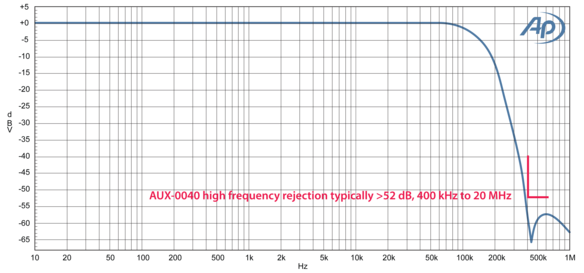
Tell skrev:Vid blind lyssning då?
För jag är skeptisk till att disten i diskanten skulle vara speciellt märkbart ens för en kräsen lyssnare. Jag vet iaf att Amir på ASR inte anser att diskantdisten är något problem alls då övertonerna hamnar utanför det hörbara området ändå. Men ni menar att han helt glömt av att IMDn kan påverka ner i det hörbara området? Gäller det isf på hörbara nivåer med tanke på hur relativt lite energi musik har där uppe?
Bruno skrev:The solution is to blast the amplifier to near-clipping with two sine waves right at the end of the audio band and to inspect the resulting spectrum. You’ll agree that this is just about the worst possible test signal that still technically qualifies as “audio”. Nothing like it ever occurs in real music, so it’s a proper stress test....
...
Even for linear amplifiers, I consider this intermodulation (IMD) test more meaningful than a non-bandlimited THD test with 20kHz. Fortunately, at least one Hi-Fi publication does this test as standard. It saves me from having to read the review.
THD+N results get rapidly worse, at higher frequencies (>4kHz), when we use higher measuring bandwidth (BW) than 22kHz. 22KHz allows only for 3rd harmonics of 7kHz sine tone, which is insufficient to estimate amplifier's non-linearity. It was usual, in the days of linear amplifiers, to use much wider BW, at least 80kHz, when measuring THD and THD+N.
Unless specified, assume a 1kHz sinewave, 10W output, 8-ohm loading, 10Hz to 90kHz bandwidth
The chart above shows THD ratios at the C 298’s output into 8 ohms as a function of frequency (20Hz to 20kHz) for a sinewave stimulus at the balanced line-level inputs. The blue and red plots are for left and right channels at 1W output into 8 ohms, purple/green at 10W, and pink/orange at the rated 185Wpc.


Shown above is the FFT of the intermodulation (IMD) products for an 18kHz + 19kHz summed sinewave stimulus tone at the balanced input. The input RMS values are set at -6.02dBrA so that, if summed for a mean frequency of 18.5kHz, would yield 10W (0dBrA) into 8 ohms at the output. We find that the second-order modulation product (i.e., the difference signal of 1kHz) is at about -125dBrA for the right channel, -135dBrA for the left, while the third-order modulation products, at 17kHz and 20kHz, are just below -110dBrA. These are all extremely low values.

I-or skrev:Tell skrev:Vid blind lyssning då?
För jag är skeptisk till att disten i diskanten skulle vara speciellt märkbart ens för en kräsen lyssnare. Jag vet iaf att Amir på ASR inte anser att diskantdisten är något problem alls då övertonerna hamnar utanför det hörbara området ändå. Men ni menar att han helt glömt av att IMDn kan påverka ner i det hörbara området? Gäller det isf på hörbara nivåer med tanke på hur relativt lite energi musik har där uppe?
IMD leder till skillnadstoner som hamnar i det hörbara området.
Medan medelnivåerna är låga i toppoktaven så är toppnivåerna höga och ibland t.o.m. extremt höga. För att hantera topparna behöver man massor av effekt även över 7 eller t.o.m. 10 kHz, vilket är lätt att demonstrera.
Nedan ser vi resultatet av att simulera effektbehovet för en ganska typisk högtalare, Monitor Audio Silver 300, som drivs med en maximal spänning om 56,6 Vp (motsvarande 200 Wrms sinus i 8 Ω) med musiksignal.
Vi exemplifierar med spåret Michael Ruff - Speaking in Melodies - Wishing Well (välinspelad fusion) som exempel, då det förekommer ett flertal högfrekvenstoppar som kräver massor av effekt från förstärkaren här. Först visas spänning, strömstyrka och effekt för hela signalen:
Som synes kommer vi upp i en aktiv effekt om 710 Wp som mest.
Sedan tittar vi enbart på frekvenser över 7 kHz (HP-filtrering med 3:e ordningens Butterworth):
För frekvenser över 7 kHz kommer vi upp i en aktiv effekt om ca 425 Wp. Dessutom inträffar den kraftigaste högfrekvenstoppen inte samtidigt som den kraftigaste toppen för den totala signalen.
Vi kan även titta enbart på frekvenser över 10 kHz (HP-filtrering med 3:e ordningens Butterworth):
För frekvenser över 10 kHz kommer vi upp i en aktiv effekt om ca 225 Wp. Dessutom inträffar den kraftigaste högfrekvenstoppen inte samtidigt som den kraftigaste toppen för den totala signalen.
Här finner den intresserade betydligt mer om dessa simuleringar för Monitor Audio Silver 300 och ett flertal andra högtalare: viewtopic.php?p=2327955#p2327955
genstruktur skrev:Morello skrev:Ha i åminnelse att klass-D-apparater ofta mäts med lågpassfilter mellan testobjekt och analysator:
"The C 298 has an output stage operating in class-D, so I inserted an Audio Precision auxiliary AUX-0025 passive low-pass filter between the test load and my Audio Precision SYS2722 system (see the January 2008 "As We See It"). This filter eliminates RF noise that could drive the SYS2722's input circuitry into slew-rate limiting, and I used it for all the tests other than frequency response."
AUX 0025 har en öfvre gränsfrekvens om 25 kHz, vilket medför att THD-mätningar över cirka 7 kHz ger nonsensdata.
"Drive input circuitry into slew-rate limiting"
Vad betyder det där egentligen? Kör även Amir på ASR med ett
Audio Precision auxiliary AUX-0025 passive low-pass filter när han mäter klass D förstärkare? (Och allt över 7kHz ger nonsensdata)
Zappa skrev:Jag är väldigt nöjd med mitt VTV NCx500, ljudkvaliteten är riktigt bra i mina öron och jag har aldrig saknat mitt tidigare Rotel RB-1582. Tyvärr har VTV-steget gått sönder. Just nu använder jag istället ett AUDIOPHONICS AP300-S500NC NCore NC502MP till mina Sonicloper, och det låter också bra. Planen är att använda AP300-S500NC för basarna när VTV-steget är reparerat. För min del räcker den främsta klass-D-tekniken mer än väl, och jag har svårt att föreställa mig att jag skulle gå tillbaka till ett klumpigt och dyrt klass AB-slutsteg.
eljulio skrev:Zappa skrev:Jag är väldigt nöjd med mitt VTV NCx500, ljudkvaliteten är riktigt bra i mina öron och jag har aldrig saknat mitt tidigare Rotel RB-1582. Tyvärr har VTV-steget gått sönder. Just nu använder jag istället ett AUDIOPHONICS AP300-S500NC NCore NC502MP till mina Sonicloper, och det låter också bra. Planen är att använda AP300-S500NC för basarna när VTV-steget är reparerat. För min del räcker den främsta klass-D-tekniken mer än väl, och jag har svårt att föreställa mig att jag skulle gå tillbaka till ett klumpigt och dyrt klass AB-slutsteg.
Det är detta som jag har som du använder just nu alltså? https://www.audiophonics.fr/en/power-am ... aDzmBzCUu4
Zappa skrev:Johan_Lindroos skrev:Samtliga klass-D-konstruktioner jag har lyssnat på har snabbt visat sig gravt undermåliga redan vid öppna lyssningar. Det är som att man undrar om något är trasigt i dem.
Har du lyssnat på någon konstruktion som bygger på Hypex NCx500 eller Purifi 1ET9040BA?
Morello skrev:Zappa, det är inte någon hemlighet att det finns en hel del underhaltiga slutsteg, men det finns också högpresterande apparater. Sybarite audio No 1200 uppvisar THD om 0,003% vid 20 kHz och 200 W i 8 ohm - mätt med en bandbredd om 80 kHz.
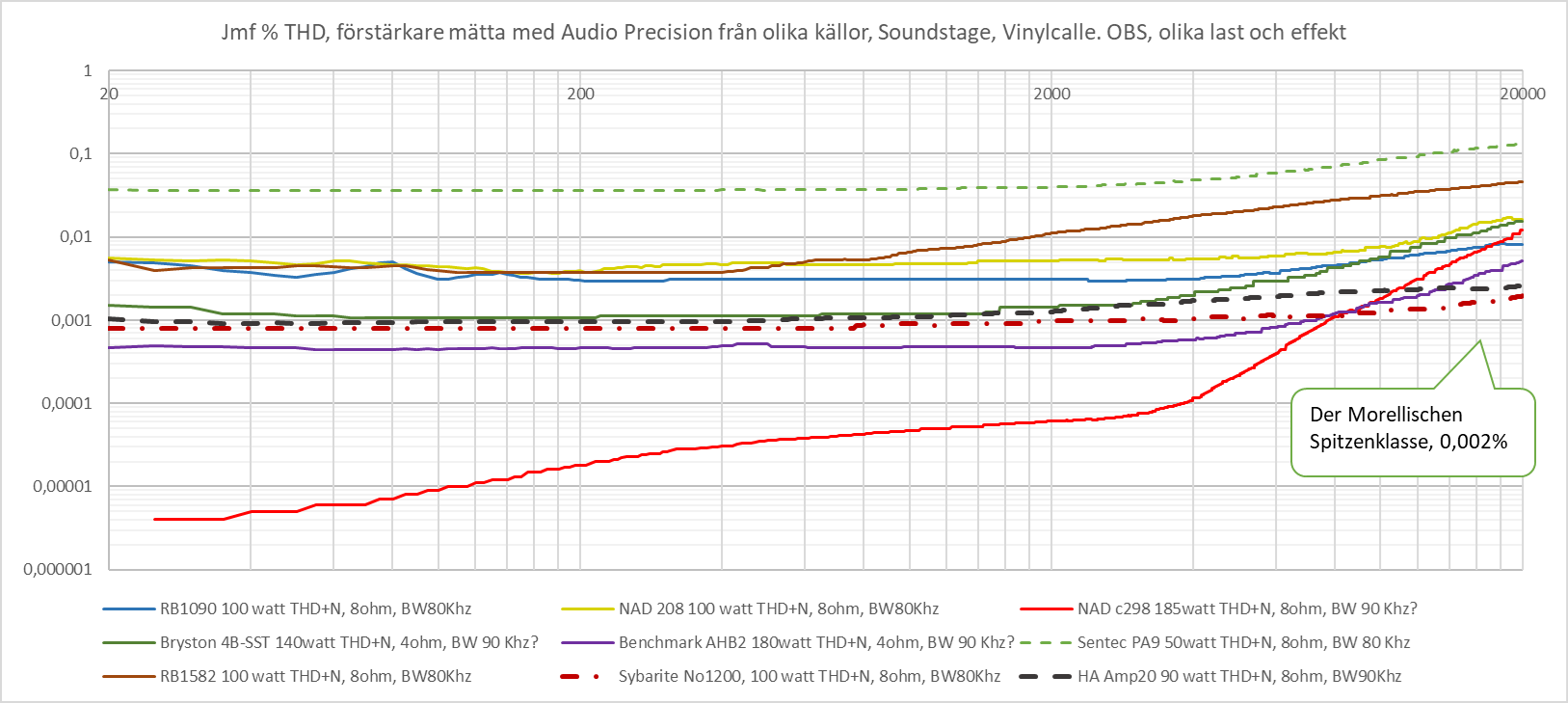
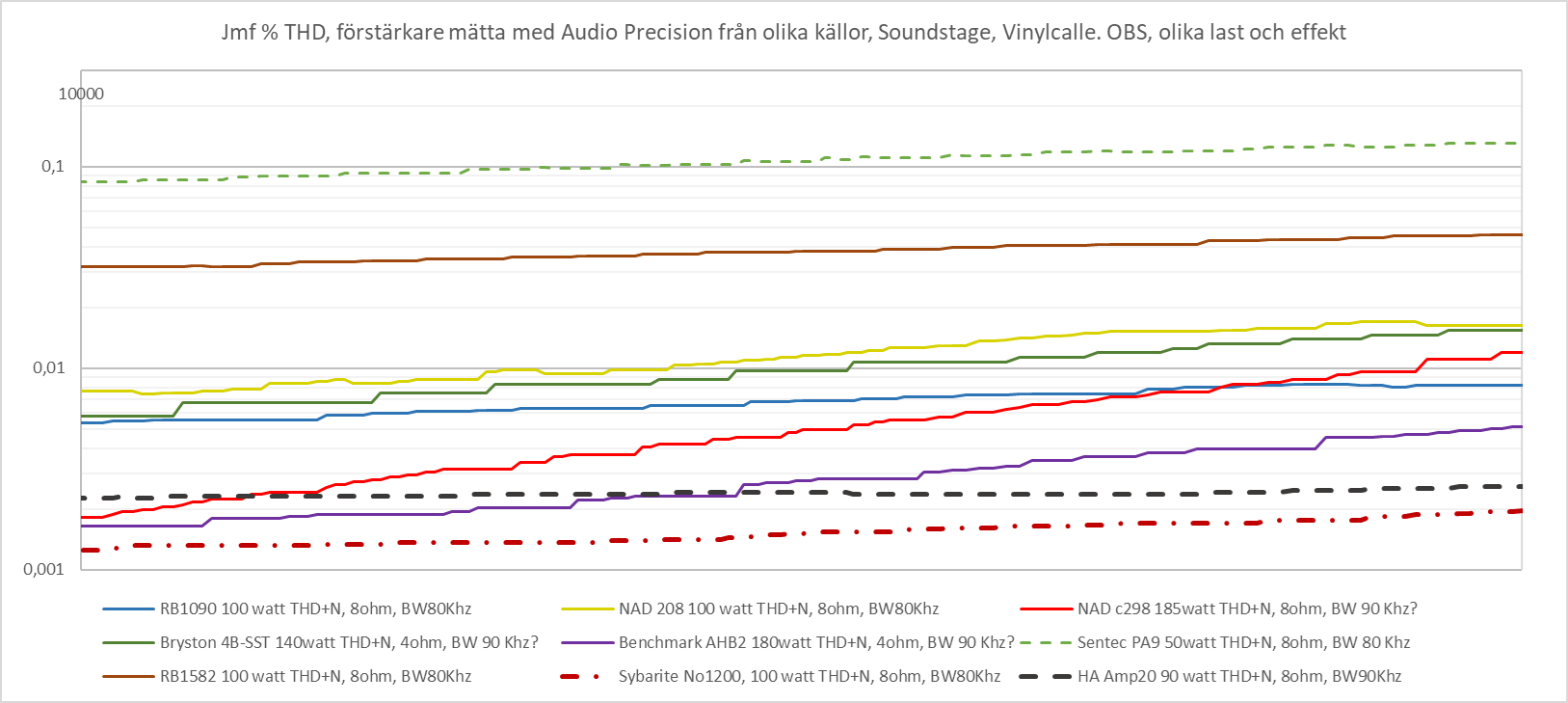
JA skrev:Discussed this with Kal and Jim Austin this morning, Dylan. We are in agreement that you should ship a pair of amplifiers to me for measurement. If both are behaving correctly, Kal will then audition them and Stereophile will publish a followup.
....
John Atkinson
Technical Editor, Stereophile
BuckeyeAmps skrev:Luckily, the Stereophile monoblocks were the only affected builds we had shipped with this defect. And while people will ask why we didn't thoroughly test it before sending out for a high-end review...because I do not cherry pick. Our measurement testing involves picking a few components whenever we receive a new batch (amp modules, SMPS', buffer boards, etc) and testing those. It just so happens we didn't pick the bad module from the early batch to test....
....
But we don't have an AP anymore.
And Purifi and Hypex do already do QC testing.
But since humans are human, mistakes will always happen no matter how rigorous we make procedures/QC/inspections.
Class-D amplifiers are measured with brick-wall AES17 filters that ignore the switching noise above 20 kHz or 40 kHz. Tweeters can demodulate this ultrasonic noise and fold it into the audible band.
Class-D amplifier switching noise can create problems in a loudspeaker measurement system. More importantly, this ultrasonic noise may become audible when it is demodulated by the non-linearities that occur in all loudspeakers. This potential source of distortion may detract from our musical enjoyment. Class-D amplifiers are compact and cheap, but are not necessarily a good choice for a high-end Hi-Fi system.
pLudio skrev:NAD C 298 med 1 kHz testsignal på 10 W. IMD-testet har tyvärr bara 24 kHz bandbredd. Klicka på bilden.
[ Bild ]
eljulio skrev:Här är en för stereobruk: https://www.audiophonics.fr/en/power-am ... 19233.html
"Each channel of the Audiophonics HPA-DM500NIL features its own Class D Hypex Nilai500DIY amplifier module. These, integrated in a dual-mono architecture, ensure exceptional sonic performance, and enable the development of significant power, with no less than 500W per channel at 4Ω. Each module features high-end components, including a totally discrete buffer stage and high-quality voltage regulators, as well as a brand-new control loop technology. The result is a drastic reduction in distortion, noise and output impedance, enabling the HPA-DM500NIL to reveal a rich, precise sound with a wide soundstage."
Finns det någon för- eller nackdel med "dual mono"?
eljulio skrev:Kul med två bra svenska steg, båda konstruktörer vi känner till också. Finns det något klass D steg uppmätt som kvalar in på denna lista med rejäl effekt. Tyckte effekten gjorde skillnad hos mig samt att jag slapp transformatorljudet... löste sig dock med hjälp.
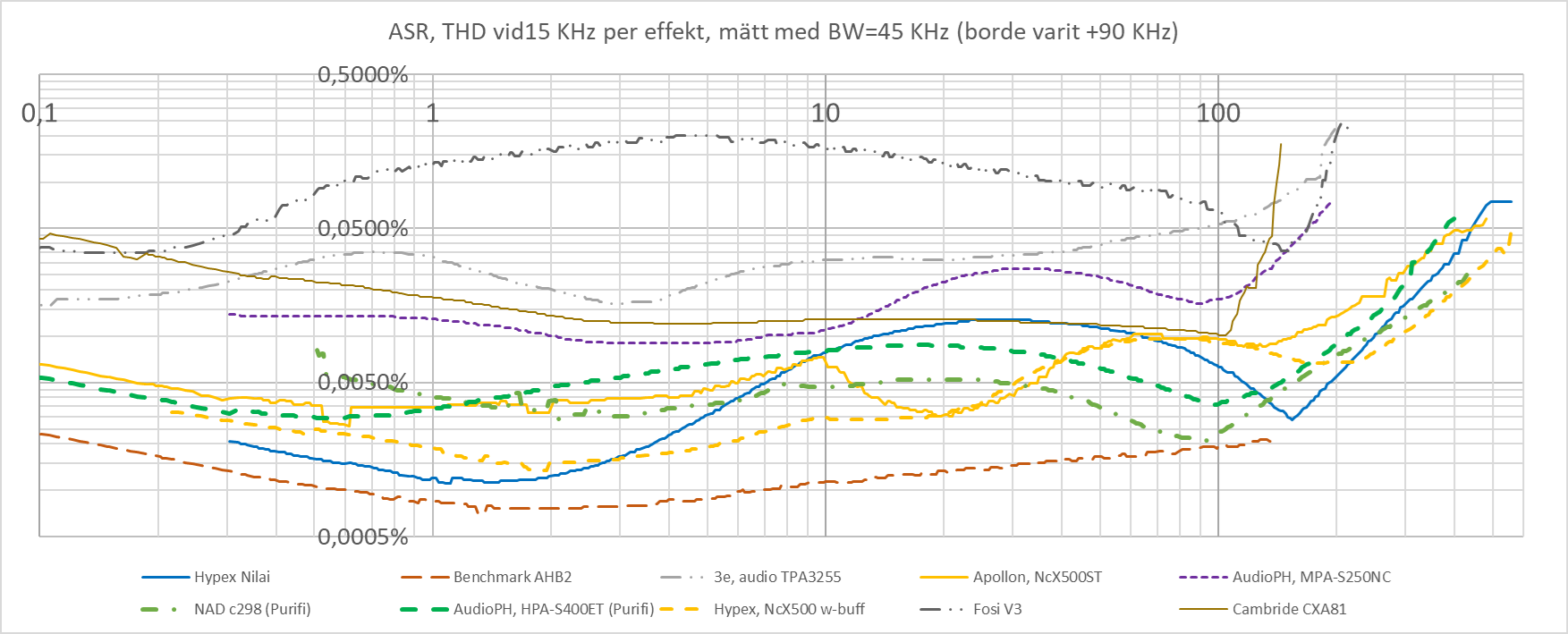
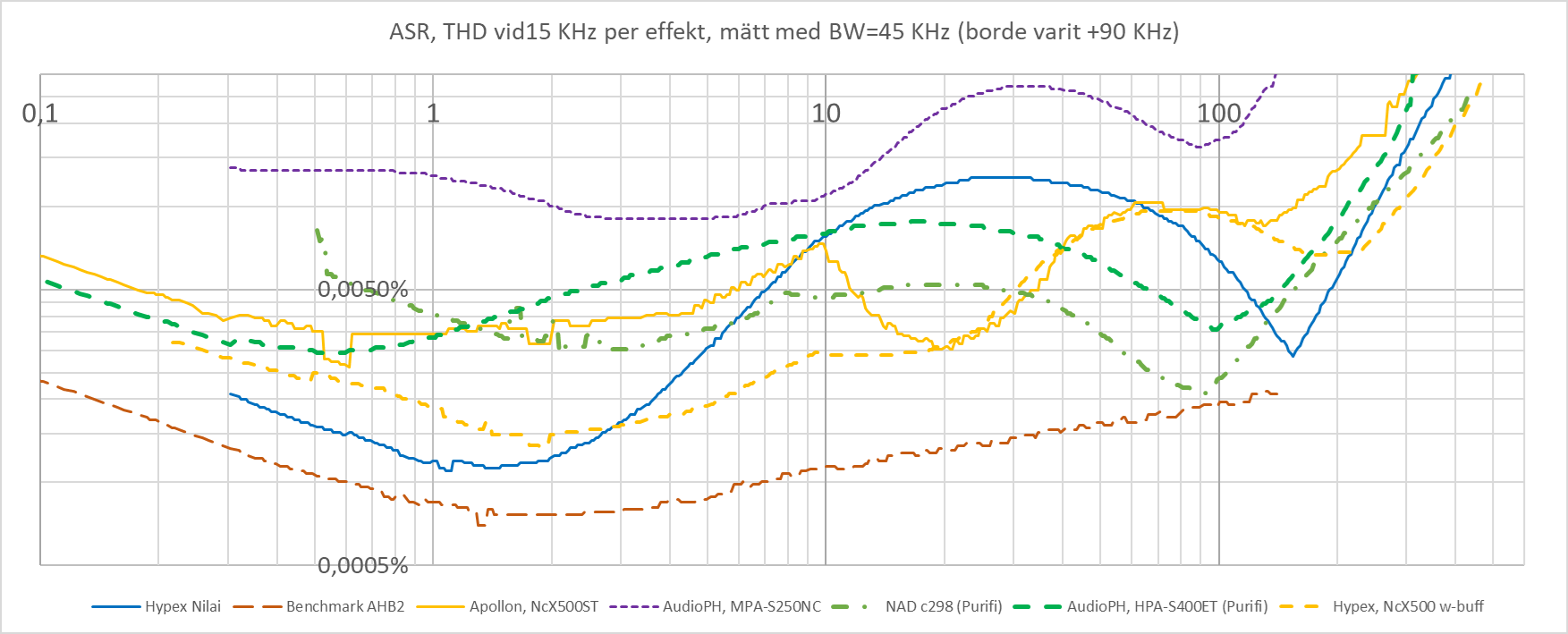
Conclusions
The electronics under test here delivered the goods, noiselessly, efficiently, and with tons of power. I have some quibbles, but not with the performance — the measured results are absolutely outstanding. I think that in 2023, any preamp should have digital and USB inputs. I really wish that the power amp power switch was more visible. And... well... that’s about it.
Hypex continues to bring out superb products showing smart engineering. When they claim “load independent,” they’re not kidding. The amplifiers handled everything I threw at them flawlessly including torturous reactive loads. The preamplifier matched the amp’s performance and added a very user friendly (and likely highly reliable) user interface. The Nilai line is killer good. Highly recommended.
genstruktur skrev:pLudio skrev:NAD C 298 med 1 kHz testsignal på 10 W. IMD-testet har tyvärr bara 24 kHz bandbredd. Klicka på bilden.
[ Bild ]
Kan de där tonerna från 500k och 1M leta sig ner i diskanten och ge upphov till distorsion?
Bruno & Lars skrev:Benchmark skrev:“The important difference between the AHB2 and class-D amplifiers is that the AHB2 does not produce switching noise. Class-D amplifiers are measured with brick-wall AES17 filters that ignore the switching noise above 20 kHz or 40 kHz. Tweeters can demodulate this ultrasonic noise and fold it into the audible band.”
That’s a curiously shaky argument to put forward in favour of a fine amplifier like the AHB2. It doesn’t need to make any excuses. I imagine that it was just a throwaway comment, otherwise it’d qualify as Spreading Uncertainty and Doubt.
I am fully aware that literature exists testing tweeters at blistering levels with signals close to the audio band, but it’s quite a stretch to extrapolate from there to a small 500kHz residual and side bands. Keep in mind that the electrical impedance of a speaker goes up with frequency so the residual (heavily attenuated by the LC filter) amounts to an absolutely tiny current.
....snip...
Bruno & Lars skrev:Fred Jacquot skrev: About correlation between sinewaves and music, we see more and more the 32 tones test (32 sines equally spaced on log scale from 20Hz to 20 kHz).
From an instinctive standpoint, it looks like being closer to a musical signal than 1 or 2 sines. Is the instinct not to be trusted in this case?
There’s nothing wrong with your instinct, and the 32 tone test is perfectly sensible. Keith Johnson already used a cluster of 8 tones in the 90’s. He said that for AD/DA this was an excellent indicator of sonic transparency. To my ears his HDCD encoder box is still the gold standard in sonically transparent AD/DA so I’m not about to disagree.
The more complex the test signal, the more likely you are to separate out the different nonlinearities that together make up amplifier distortion. On the other hand, it becomes harder to read the graphs. Once you use more than 2 sine waves the plots become quite hard to interpret. You have to do some calculations to work out what particular combination of tones underlies a particular spur.
Amir skrev:I matched levels with Benchmark AHB2. I was surprised to see so much lower intermodulation distortion with 1ET400A. The first pair of sidebands is more than 10 dB cleaner and the rest almost don't exist! Well done. I let Bruno explain why this is so.
Bruno Putzeyes skrev:Anyhow, this is why I like to test amplifiers with test signals that in themselves would be audible (i.e. fit below 20kHz) and also read the distortion and noise only in the band below 20kHz. Of course, I know perfectly well that if you then do a THD versus frequency sweep, any readings above 10kHz are meaningless because even the second harmonic will be outside the audio band. But as our sensitivity to those harmonics drops off rather quickly around 20kHz (as does the ability of most speakers to reproduce them), it's fair to conclude that they do not say much about sound. On the other hand, we can't just go ignoring any underlying non-linearity. We still need to test for misbehaviour at high frequencies. If you choose to limit measurement bandwidth to 20kHz you have to include something like the 19kHz + 20kHz test. I didn't invent that procedure btw, I got that from Bruce Hofer at AP who recommends it. In fact his version is even neater, he uses 19.5kHz and 18.5kHz, making sure that even order products sit at even multiples of 500Hz (from 1kHz upward) while odd products sit at odd multiples of 500Hz, from 17.5kHz down, potentially fitting 37 distinct IMD products inside the band. This refinement doesn't make much difference with the 1ET400 amp of course since there aren't that many IMD products poking up over the noise floor.
Given the choice between a sinewave test at 20kHz which only produces inaudible products and a two-tone test that produces all kinds of in-band distortion I go for the latter. By implication, we should be designing a control loop that maximises loop gain all the way up to 20kHz, but not beyond. Any control system obeys a law called the Bode Inequality. This is the closest we control theorists have to mass-energy conservation. In the case of a class D amplifier it implies that if you maximise loop gain over a largeish fraction of the switching frequency you'll have to take it down really fast afterwards. So that's why the wideband THD vs frequency plot goes up somewhat suddenly at the end. It's a compromise I'm knowingly making. Consider the alternative: I could instead pander to the bat-eared crowd and choose to minimise harmonic distortion components up to 40kHz, say. That would mean accepting a lot less loop gain below 20kHz and hence higher distortion in the audible frequency range. It's not a good tradeoff.
Anyhow, this should explain why the high-frequency IMD spectrum is so much cleaner than a wideband THD test would lead you to expect. But as I see it, the former is the one that is most likely to have a meaningful correlation to sound.
distad skrev:Är det bara jag som undrar/reflekterar över kvaliteten på hållbarheten på dessa klass Demot de numera hemska klass AB.
Hur länge håller dessa lådor egentligen jämfört emot AB slutsteg
Har sett att det funnits några trasiga klass D till salu begagnat, som köpt ifrån den där Franska sajten. Och Zappa, vad är det som gett upp på ditt klass D slutsteg
Att grejerna håller är "viktigast för min del", men jag har ju inte råd att byta ofta...
Sedan har jag förstått att de blir bättre och bättre ljudmässigt. Men att grejerna håller är minst lika viktigt som ljudet, tycker jag då. Finns ju vanliga trisse steg som varit i drift i 15-20år utan service /repartition och det börjar man undra starkt över när det gäller klass D...
Användare som besöker denna kategori: dewpo, RogerGustavsson, VintageHiFi och 28 gäster